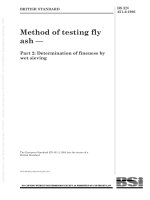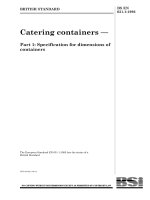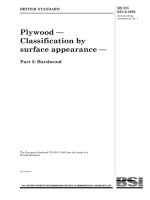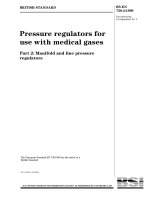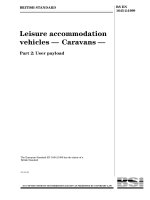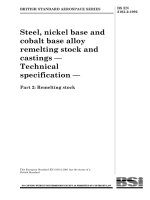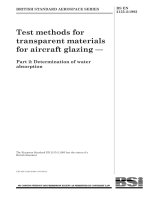Bsi bs en 00623 2 1993 (1999)
Bạn đang xem bản rút gọn của tài liệu. Xem và tải ngay bản đầy đủ của tài liệu tại đây (482.62 KB, 14 trang )
BRITISH STANDARD
Advanced technical
ceramics —
Monolithic ceramics —
General and textural
properties —
Part 2: Determination of density and
porosity
The European Standard EN 623-2:1993 has the status of a
British Standard
UDC 666.5/.6:620-1:531.75
BS EN
623-2:1993
BS EN 623-2:1993
Cooperating organizations
The European Committee for Standardization (CEN), under whose supervision
this European Standard was prepared, comprises the national standards
organizations of the following countries:
Austria
Belgium
Denmark
Finland
France
Germany
Greece
Iceland
Ireland
Italy
Luxembourg
Netherlands
Norway
Portugal
Spain
Sweden
Switzerland
United Kingdom
This British Standard, having
been prepared under the
direction of the Refractory
Products Standards Policy
Committee, was published
under the authority of the
Standards Board and comes
into effect on
15 November 1993
© BSI 10-1999
The following BSI references
relate to the work on this
standard:
Committee reference RPM/13
Draft for comment 92/36001 DC
ISBN 0 580 21772 8
Oesterreichisches Normungsinstitut
Institut belge de normalisation
Dansk Standardiseringsraad
Suomen Standardisoimisliito, r.y.
Association franỗaise de normalisation
Deutsches Institut für Normung e.V.
Hellenic Organization for Standardization
Technological Institute of Iceland
National Standards Authority of Ireland
Ente Nazionale Italiano di Unificazione
Inspection du Travail et des Mines
Nederlands Normalisatie-instituut
Norges Standardiseringsforbund
Instituto Portugs da Qualidade
Asociación Espola de Normalización y Certificación
Standardiseringskommissionen i Sverige
Association suisse de normalisation
British Standards Institution
Amendments issued since publication
Amd. No.
Date
Comments
BS EN 623-2:1993
Contents
Cooperating organizations
National foreword
Foreword
Text of EN 623-2
National annex NA (informative) Committees responsible
National annex NB (informative) Cross-references
© BSI 10-1999
Page
Inside front cover
ii
2
3
Inside back cover
Inside back cover
i
BS EN 623-2:1993
National foreword
This British Standard has been prepared under the direction of the Refractory
Products Standards Policy Committee and is the English language version of
EN 623-2 Advanced technical ceramics — Monolithic ceramics — General and
textural properties — Part 2: Determination of density and porosity published by
the European Committee for Standardization (CEN). It supersedes
BS 7134-1.2:1989 which is withdrawn.
EN 623-2 was produced as a result of international discussions in which the UK
took an active part.
A British Standard does not purport to include all the necessary provisions of a
contract. Users of British Standards are responsible for their correct application.
Compliance with a British Standard does not of itself confer immunity
from legal obligations.
Summary of pages
This document comprises a front cover, an inside front cover, pages i and ii,
the EN title page, pages 2 to 8, an inside back cover and a back cover.
This standard has been updated (see copyright date) and may have had
amendments incorporated. This will be indicated in the amendment table on the
inside front cover.
ii
© BSI 10-1999
EUROPEAN STANDARD
EN 623-2
NORME EUROPÉENNE
September 1993
EUROPÄISCHE NORM
UDC 666.5/.6:620.1:531.75
Descriptors: Ceramics, characteristics, tests, determination, bulk density, porosity, quality
English version
Advanced technical ceramics — Monolithic ceramics —
General and textural properties —
Part 2: Determination of density and porosity
Céramiques techniques avancées —
Céramiques monolithiques — Propriétés
générales et structurales — Partie 2:
Détermination de la masse volumique et de la
porosité
Hochleistungskeramik — Monolithische
Keramik — Allgemeine und strukturelle
Eigenschaften — Teil 2: Bestimmung von
Dichte und Porosität
www.bzfxw.com
This European Standard was approved by CEN on 1993-08-30. CEN members
are bound to comply with the CEN/CENELEC Internal Regulations which
stipulate the conditions for giving this European Standard the status of a
national standard without any alteration.
Up-to-date lists and bibliographical references concerning such national
standards may be obtained on application to the Central Secretariat or to any
CEN member.
This European Standard exists in three official versions (English, French,
German). A version in any other language made by translation under the
responsibility of a CEN member into its own language and notified to the
Central Secretariat has the same status as the official versions.
CEN members are the national standards bodies of Austria, Belgium,
Denmark, Finland, France, Germany, Greece, Iceland, Ireland, Italy,
Luxembourg, Netherlands, Norway, Portugal, Spain, Sweden, Switzerland and
United Kingdom.
CEN
European Committee for Standardization
Comité Européen de Normalisation
Europäisches Komitee für Normung
Central Secretariat: rue de Stassart 36, B-1050 Brussels
© 1993 Copyright reserved to CEN members
Ref. No. EN 623-2:1993 E
EN 623-2:1993
Foreword
This European Standard has been prepared by
Technical Committee CEN/TC 184 “Advanced
technical ceramics” the secretariat of which is held
by BSI.
EN 623 Advanced technical ceramics — Monolithic
ceramics — General and textural properties consists
of four Parts:
— Part 1: Determination of the presence of defects
by dye penetration tests;
— Part 2: Determination of density and porosity;
— Part 3: Determination of grain size1);
— Part 4: Determination of surface roughness1).
The European Standard shall be given the status of
a national standard, either by publication of an
identical text or by endorsement, at the latest by
March 1994, and conflicting national standards
shall be withdrawn at the latest by March 1994.
In accordance with the CEN/CENELEC Internal
Regulations, the following countries are bound to
implement this European Standard: Austria,
Belgium, Denmark, Finland, France, Germany,
Greece, Iceland, Ireland, Italy, Luxembourg,
Netherlands, Norway, Portugal, Spain, Sweden,
Switzerland and United Kingdom.
1)
2
Contents
Foreword
1
Scope
2
Normative references
3
Definitions
4
Statement of accuracy and errors
5
The evacuation method (Method 1)
6
Method by measurement of
dimensions and mass (geometric
bulk density) (Method 2)
7
Test report
Table 1 — Accuracy and errors of
density and porosity measurement
Table 2 — Density of distilled water
as a function of temperature
between 15 °C and 30 °C
Page
2
3
3
3
3
4
6
7
4
5
www.bzfxw.com
Parts 3 and 4 of this European Standard will be published as ENV.
© BSI 10-1999
EN 623-2:1993
1 Scope
3 Definitions
This Part of EN 623 describes methods for
determination of the bulk density, apparent solid
density, and apparent porosity of advanced
technical ceramics.
Two methods are described and are designated as
Methods 1 and 2, as follows.
Method 1. Determination of bulk density,
apparent solid density and apparent porosity by
the evacuation method.
For the purposes of this Part of EN 623 the
following definitions apply.
NOTE 1 This method is not suitable for the determination of
apparent porosity of less than 1 %. A method for determining
the presence of defects and surface porosity in this type of
material is given in EN 623-1.
NOTE 2 The method is also not suitable for materials which
are known to have an average pore size of greater
than 200 Èm.
Method 2. Determination of bulk density only, by
measurement of dimensions and mass.
NOTE 3 Neither of these test methods measures total
porosity including open and closed pores. This parameter may
be calculated from the test results of Method 1 if the true
density of pore-free material is known.
2 Normative references
pores that are penetrated by an immersion liquid in
vacuum, or that are connected with the atmosphere,
either directly or via one another
3.2
closed pores
pores that are not penetrated by the immersion
liquid, or that are not connected with the
atmosphere
3.3
bulk volume Vb
the sum of the volumes of the solid material, the
open pores and the closed pores in a porous body
3.4
true volume
the volume of a body occupied by solid material,
excluding all forms of porosity
www.bzfxw.com
This European Standard incorporates by dated or
undated reference, provisions from other
publications. These normative references are cited
at the appropriate places in the text and the
publications are listed hereafter. For dated
references, subsequent amendments to or revisions
of any of these publications apply to this European
Standard only when incorporated in it by
amendment or revision. For undated references the
latest edition of the publication referred to applies.
EN 623-1, Advanced technical ceramics —
Monolithic ceramics — General and textural
properties — Part 1: Determination of the presence of
defects by dye penetration tests.
EN 45001, General criteria for the operation of
testing laboratories.
EN 1006, Advanced technical ceramics — Methods
of testing monolithic ceramics — Guidance on the
sampling and selection of test pieces.
ISO 758:1976, Liquid chemical products for
industrial use — Determination of density at 20 °C.
ISO 3611:1978, Micrometer callipers for external
measurement.
ISO 4964:1984, Steel — Hardness conversions.
ISO 6906:1984, Vernier callipers reading
to 0,02 mm.
© BSI 10-1999
3.1
open pores
3.5
apparent solid volume Vs
the sum of the volume of the closed pores and true
volume
3.6
bulk density Ôb
the ratio of the mass of the dry material of a porous
body to its bulk volume
3.7
geometric bulk density
the mass per unit total volume of a material
including all porosity accessible and in accessible
from the surface, the volume being calculated from
linear dimensions
3.8
apparent solid density Ôs
the ratio of the mass of the dry material to its
apparent solid volume
3.9
apparent porosity Ïa
the ratio of the total volume of the open pores in a
porous body to its bulk volume
4 Statement of accuracy and errors
The minimum accuracy of measurement of the
parameters used in calculation of densities and
porosities is given in Table 1.
3
EN 623-2:1993
Table 1 — Accuracy and errors of density and porosity measurement
Method 1:
Evacuation method
(see clause 5)
Method 2:
Geometric bulk density
(see clause 6)
Minimum test piece dimension in mm —
3,0
Accuracy of measurement of
dimensiona
—
0,01 mm or 0,05 % of smallest
dimension
Minimum test piece mass in g
1
2
30
2,0
Accuracy of weighing in g
0,0001
0,001
0,01
0,001
Accuracy of measurement of density of 0,0001
immersion liquid, (Mg/m3);
see 5.5 and Table 2
0,001
0,001
—
Accuracy of density measurement (%) 0,3
a
1,0
The maximum non-uniformity of any dimension should not exceed 1 % of its average value.
5 The evacuation method (Method 1)
5.1 Principle
The mass of dry test piece is determined by
weighing, then its apparent mass when immersed in
a liquid with which it has been impregnated under
vacuum, and then its mass in air while still soaked
with the liquid. From these values its bulk density
and apparent porosity are determined by
calculation.
NOTE Some materials may chemically react with water, others
such as boron nitride are not wetted by water. Where test pieces
of smaller volume (1 cm3 to 10 cm3) (see 5.3.1) are used, and the
error caused by evaporation of liquids is comparatively high,
dibutyl phthalate should be used.
5.2.8 Thermometer, capable of measuring to ± 0,1 K.
5.2.9 Glass beaker, of a size allowing adequate
clearance of its walls by the test piece.
5.2.10 Desiccator, for storage of test pieces.
www.bzfxw.com
5.2.11 Manometer
5.2 Apparatus
5.2.12 Absorbent cloth or tissue paper
5.2.1 Drying oven, capable of maintaining a
temperature of 110 °C ± 5 °C.
5.2.2 Balance with accuracy in accordance with
clause 4.
5.2.3 A bridge, to be placed over the load-bearing
scale pan of the balance (see 5.2.2), if the balance is
not equipped for suspension loading.
5.2.4 Evacuating equipment, capable of reducing the
pressure to a value less than 2 500 Pa (25 mbar),
and a means of measuring the pressure used.
5.3 Test pieces
NOTE If a rotary vacuum pump is used, it should be fitted with
a moisture trap, to minimize the mixing of water and the pump
lubrication system.
5.2.5 Degreased metal wire, of diameter not more
than 0,15 mm.
5.2.6 Cradle to contain test piece(s) (optional).
5.2.7 Immersion liquid, which may be either:
a) cold distilled water, containing a dilute
solution of a surface active agent (concentration
not more than 0,01 %), the addition of which does
not change the densities given in Table 2; or
b) an organic liquid, which shall be used for
materials that are sensitive to contact with water
or that cannot be fully wetted by water.
4
5.3.1 Materials for testing shall be sampled in
accordance with the guidance given in ENV 1006.
Test pieces shall be either whole or broken ceramic
products, or shall be cut from blocks or rods of the
same material. The bulk volume of a test piece shall
be not less than 1 cm3, and its mass shall be greater
than 1 g (see Table 1 and note 2).
NOTE 1 When the apparent porosity is greater than 10 %, the
ratio of the longest to the shortest dimension of a test piece
should not exceed 2 : 1.
NOTE 2 For test pieces of mass 1 g to 3 g, significant sources of
error include temperature, air content of liquid and the
consistency of the liquid level position on the suspension wire.
These factors should be kept constant.
5.3.2 If any surface treatment such as the removal
of “skin” is carried out this shall be reported in the
test report (see clause 7).
NOTE Since it is necessary to sponge the surface of the test
piece to remove surface moisture, the test pieces should not have
inaccessible external surfaces or very rough surfaces.
5.4 Procedure
5.4.1 Determination of the mass of the dry test
piece
Dry the test piece in the oven (see 5.2.1)
at 110 °C ± 5 °C to constant mass, i.e. until two
successive weighings made before and after at
least 2 h in the drying oven do not differ by more
than 0,03 %.
© BSI 10-1999
EN 623-2:1993
Before each weighing, place the test piece in the
desiccator (see 5.2.10), until it has cooled to room
temperature, and weigh it as quickly as possible
after removal from the desiccator. The mass thus
determined is the mass of the dry test piece (m1),
weighed in accordance with Table 1.
5.4.2 Soaking of test piece
Place the cooled and dried test piece in an airtight
vessel. Seal the vessel and evacuate it until a
pressure of less than 2 500 Pa is attained; maintain
this vacuum for at least 15 min. In order to ensure
that all the air has been removed from the test piece,
isolate or disconnect the vessel from the vacuum
pump and use the manometer (see 5.2.11) to check
that the pressure does not rise through any
degassing of the test piece. Progressively introduce
the immersion liquid in such a way that,
after 3 min, the test piece is covered by
about 20 mm of liquid. Reconnect the vessel to the
vacuum pump and maintain this reduced pressure
for 30 min, then switch off the pump and open the
vessel to ambient air pressure. Wait for at least a
further 30 min to ensure complete penetration of
the test piece by the liquid.
NOTE If such loss occurs, the test should be repeated using a
different immersion liquid (see note to 5.2.7).
Record the mass thus determined as the mass of the
soaked test piece (m3), weighed in accordance with
Table 1. Repeat the immersion, drying and
weighing.
If the results for each test piece differ by more than
the relevant accuracy figures given in Table 1,
repeat the test until two sets of figures meet these
criteria.
5.5 Determination of the density of the
immersion liquid
Determine the density of the liquid used in the
operation at the temperature of the test, using the
method given in ISO 758:1976, to the accuracy given
in Table 1.
NOTE 1 For distilled water, the density at various
temperatures is given in Table 2.
NOTE 2 As many organic solvents have high coefficients of
volume thermal expansion, the determination of density of the
liquid should be carried out at the same temperature as that of
the measurement of the apparent mass of the immersed test
piece (see 5.4.3)
Table 2 — Density of distilled water as a
function of temperature between 15 °C
and 30 °C
www.bzfxw.com
NOTE If there is any doubt about the completion of penetration
within 30 min, this period may be extended by agreement
between parties as required.
5.4.3 Determination of the apparent mass of the
immersed test piece
Suspend the test piece by the thin wire (see 5.2.5)
from the load-pan suspension point of the balance,
perpendicular to the liquid, and weigh it while
completely immersed in a quantity of the immersion
liquid, contained in the beaker (see 5.2.9), standing
on the bridge (see 5.2.3) if used. Remove bubbles
from the surface of the test piece and weigh. Remove
the test piece from the suspension wire, replace the
wire in the liquid to the same suspension level and
weigh. The difference between the two weighings is
the apparent mass of the immersed test piece (m2),
weighed in accordance with Table 1. Determine the
temperature of the immersion liquid, using the
thermometer (see 5.2.8).
5.4.4 Determination of the mass of the soaked
test piece
Remove the test piece from the liquid and, without
waiting, sponge it quickly and carefully with a
damp, lint-free absorbent cloth or tissue (see 5.2.12)
to remove droplets and the surface film of liquid, but
avoid drawing out liquid from the pores of the test
piece.
Immediately weigh the test piece in air. Take care to
ensure that evaporation of the immersion liquid
does not lead to any appreciable loss in mass during
the weighing operation.
© BSI 10-1999
Temperature, °C
15
16
17
18
19
20
21
22
23
24
25
26
27
28
29
30
Density, Ơ
Mg/m3
0,99910
0,99894
0,99877
0,99860
0,99841
0,99820
0,99799
0,99777
0,99754
0,99730
0,99704
0,99678
0,99651
0,99623
0,99594
0,99565
Kg/m3
999,10
998,94
998,77
998,60
998,41
998,20
997,99
997,77
997,54
997,30
997,04
996,78
996,51
996,23
995,94
995,65
5.6 Calculation of results
5.6.1 Calculate the bulk density Ôb, in either
megagrams per cubic metre or kilograms per cubic
metre from the following equation:
(1)
5
EN 623-2:1993
5.6.2 Calculate the apparent solid density Ôs, in
either megagrams per cubic metre or kilograms per
cubic metre.
(2)
5.6.3 Calculate the apparent porosity Ïa as a
percentage, (V/V) from the following equation:
(3)
where:
m1 is the mass of the dry test piece in grams
(see 5.4.1);
m2 is the apparent mass of the immersed test
piece in grams (see 5.4.3);
m3 is the mass of the soaked test piece in grams
(see 5.4.4);
ÔL is the density of the immersion liquid (see 5.5)
in megagrams per cubic metre or kilograms per
cubic metre, as appropriate to the units chosen
for the calculation.
Express the values of density in megagrams per
cubic metre or kilograms per cubic metre to three
significant digits.
Express the values of porosity to the nearest 0,1 %.
6 Method by measurement of
dimensions and mass (geometric bulk
density) (Method 2)
6.1 Principle
A test piece of uniform geometry within specified
tolerances is dried and weighed. Its volume is
determined by measurement of the appropriate
dimensions. The geometric bulk density (see 3.7) is
calculated as mass per unit volume.
6.2 Apparatus
6.2.1 Balance, with accuracy in accordance with
Table 1.
6.2.2 Calibrated measuring device capable of
repeatable and accurate measurement in
accordance with Table 1, e.g. vernier callipers in
accordance with ISO 6906:1984, or a micrometer in
accordance with ISO 3611:1978.
NOTE For flat test piece surfaces, spherical measuring anvils
with radii of curvature between 2 mm and 10 mm should be
used. For cylindrical test piece surfaces, cylindrical measuring
anvils should be used. These anvils should be constructed of
material with hardness of at least 500 HV30
(see ISO 4964:1984).
6.2.3 Drying oven, capable of maintaining a
temperature of 110 °C ± 5 °C.
6
6.2.4 Desiccator, for storage of test pieces.
6.3 Test pieces
Materials for testing shall be sampled in accordance
with the guidance given in ENV 1006. The shape of
test pieces shall be such that the volume can be
calculated from the external dimensions.
NOTE 1 Ideal shapes are rectangular parallelepipeds and right
cylinders, discs or rods.
NOTE 2 Test pieces which do not have uniform dimensions and
principal axes orthogonal to within 1° should be ground to
achieve such conditions.
The mass of the test piece shall be greater than 2 g
and each dimension shall be greater than 3 mm
(see Table 1). Where “as-fired” test pieces are used,
press flashing shall be removed.
NOTE 3 The total volume of edge chips and surface pits or
protrusions should not exceed approximately 0,1 % of the
nominal total volume.
NOTE 4 Some types of material possess surface skins which are
rough or soft in the “as-fired” state. These materials are unsuited
to this method of measurement of bulk density unless the skin is
flattened or removed by machining or other suitable method.
Reaction-bonded silicon nitride is an example where such a
surface deposit may be present.
6.4 Procedure
Dry the test pieces in the oven (see 6.2.3)
at 110 °C ± 5 °C to constant mass, i.e. until two
successive weighings made before and after at
least 2 h in the drying oven do not differ by more
than 0,03 %. Transfer them to a desiccator and
allow to cool to room temperature. Record the mass
of each test piece in ambient air, as soon as possible
after removal from the desiccator.
Using the selected measuring device (see 6.2.2),
measure the dimensions of each test piece at at least
three positions for each direction, to an accuracy
better than 0,01 mm or 0,05 % of the smallest
dimension. Measure the directions parallel to the
principal geometric axes, e.g. the length, breadth
and depth of a parallelepiped, the length and
diameter for a disc or a rod.
www.bzfxw.com
NOTE If the dimensions of the test piece are too small to make
three separate measurements in any direction, e.g. of the length
of a rod of small diameter, a single measurement may be used,
such a simplified procedure being reported [see clause 7j)].
Calculate the differences between the lowest and
highest figures measured for each direction. Reject
the test pieces if any difference exceeds 1 % of the
mean dimensions measured.
6.5 Results
Calculate the geometric volume of each test piece
from its mean dimensions. The geometric bulk
density is given by the mass divided by the
geometrical volume. Express the values of density in
megagrams per cubic metre or kilograms per cubic
metre.
© BSI 10-1999
EN 623-2:1993
7 Test report
The results shall be reported in accordance with
EN 45001 and the test report shall include the
following information:
a) the name of the testing establishment;
b) the date of the test; a unique identification of
the report and of each page, and the name and
address of the customer, and a signatory of the
report;
c) a reference to this European standard,
i.e. “Determined in accordance with
EN 623-2 and the method used, i.e. Method 1 or
Method 2 (see clause 1);
d) the identification of the test material or
component type (manufacturer, type, batch
number);
e) the number of test pieces;
© BSI 10-1999
f) the shape and surface condition of the test
pieces, and whether surfaces are as-fired or
machined (see 5.3.2 and 6.3);
g) for Method 1, the pressure to which the
vacuum chamber was reduced;
h) for Method 1, the immersion liquid used, and
the temperature of the test;
i) for Method 1, the time taken to complete the
soaking of the test piece (see 5.4.2);
j) for Method 2, any use of the simplified
measurement procedure (see 6.4);
k) the individual values and the mean value
(where required) of the bulk density and
apparent solid density expressed in either
megagrams per cubic metre or kilograms per
cubic metre, and the apparent porosity expressed
as a percentage;
l) comments on the test or test results.
7
8
blank
BS EN 623-2:1993
National annex NA (informative)
Committees responsible
The United Kingdom participation in the preparation of this European Standard was entrusted by the
Refractory Products Standards Policy Committee (RPM/-) to Technical Committee RPM/13, upon which the
following bodies were represented:
AEA Technology
Aluminium Federation
British Ceramic Research Ltd.
British Industrial Ceramic Manufacturers’ Association
Department of Trade and Industry (National Physical Laboratory)
Flat Glass Manufacturers’ Association
GAMBICA (BEAMA Ltd.)
Institute of Refractories Engineers
Ministry of Defence
Refractories Association of Great Britain
Society of British Aerospace Companies Limited
University of Manchester
National annex NB (informative)
Cross-references
Publication referred to
Corresponding British Standard
EN 45001:1989
BS 7501:1989 General criteria for the operation of testing laboratories
ISO 758:1976
BS 4522:1988 Method for determination of absolute density at 20 °C of liquid
chemical products for industrial use
© BSI 10-1999
BS EN
623-2:1993
BSI — British Standards Institution
BSI is the independent national body responsible for preparing
British Standards. It presents the UK view on standards in Europe and at the
international level. It is incorporated by Royal Charter.
Revisions
British Standards are updated by amendment or revision. Users of
British Standards should make sure that they possess the latest amendments or
editions.
It is the constant aim of BSI to improve the quality of our products and services.
We would be grateful if anyone finding an inaccuracy or ambiguity while using
this British Standard would inform the Secretary of the technical committee
responsible, the identity of which can be found on the inside front cover.
Tel: 020 8996 9000. Fax: 020 8996 7400.
BSI offers members an individual updating service called PLUS which ensures
that subscribers automatically receive the latest editions of standards.
Buying standards
Orders for all BSI, international and foreign standards publications should be
addressed to Customer Services. Tel: 020 8996 9001. Fax: 020 8996 7001.
In response to orders for international standards, it is BSI policy to supply the
BSI implementation of those that have been published as British Standards,
unless otherwise requested.
Information on standards
BSI provides a wide range of information on national, European and
international standards through its Library and its Technical Help to Exporters
Service. Various BSI electronic information services are also available which give
details on all its products and services. Contact the Information Centre.
Tel: 020 8996 7111. Fax: 020 8996 7048.
Subscribing members of BSI are kept up to date with standards developments
and receive substantial discounts on the purchase price of standards. For details
of these and other benefits contact Membership Administration.
Tel: 020 8996 7002. Fax: 020 8996 7001.
Copyright
Copyright subsists in all BSI publications. BSI also holds the copyright, in the
UK, of the publications of the international standardization bodies. Except as
permitted under the Copyright, Designs and Patents Act 1988 no extract may be
reproduced, stored in a retrieval system or transmitted in any form or by any
means – electronic, photocopying, recording or otherwise – without prior written
permission from BSI.
This does not preclude the free use, in the course of implementing the standard,
of necessary details such as symbols, and size, type or grade designations. If these
details are to be used for any other purpose than implementation then the prior
written permission of BSI must be obtained.
BSI
389 Chiswick High Road
London
W4 4AL
If permission is granted, the terms may include royalty payments or a licensing
agreement. Details and advice can be obtained from the Copyright Manager.
Tel: 020 8996 7070.
